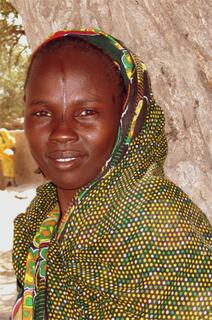
Like many places in Niger, the road to Bosso is not an easy one. Located 100 kilometers east of Diffa, the last sixty kilometers is off the main paved road and is a maze of braided tire tracks that crisscross over what was once, in ancient times, the lakebed of Lake Chad. The water from Lake Chad has long since retreated and what is left is just a vast expanse of flat, open space.
An abundance of Acacia trees and short species of golden grasses fill this openness and explain why this area is classified a pastoral zone. Rain-fed agriculture in this region is small in scale, and largely folly. Yet, so attached to millet is the Nigerien psyche, farmers still continue to plant small fields to the crop, hoping to have an above-average year of precipitation. Such gambles rarely pay out, and most households end up buying millet (or other cereals) from the market. Playing to this area’s strengths, most people here earn at least some portion of their living from livestock, which is ubiquitous.
A hardscrabble existence is the norm for most Nigeriens. Subsistence farming—a mix of agriculture and animal husbandry—is what most people do for a living. But, an increasing population and decreasing soil productivity threaten this way of life. Climate also plays a role where inadequate and poorly distributed rainfall routinely threaten harvests throughout the country, and some places—notably in the regions of Maradi, Zinder, and Diffa—face severe food shortages and drought every year. And, even in years when the rains are good and crop yields are average, a recent report showed that the most vulnerable—read poorest—households are only able to grow enough food to meet their cereal needs for just six months out of a year.
Last year, poor rains and a locust invasion left both crops and pasture in poor shape and, as a result, rendered many households vulnerable to food shortages. After last year’s disappointing harvest, estimates from the government came out showing that 2.7 million people, in 4000 communities—one-quarter of Niger’s total population—would be affected by a food shortage in coming year. Bosso, and several of the surrounding villages, were identified as being vulnerable, and were selected to receive food aid from the World Food Programme (WFP). CARE took responsibility for distributions in this region and dispatched teams to Bosso and the other villages in early October to await the delivery of rations from the WFP.
So, it was on a recent Friday morning in Bosso that the town criers began circulating at 3:30 am, their shouts and drumming rousing the villagers and CARE distribution team from sleep. During Ramadan, the holy month of fasting for Muslims, the criers—whose job it is to wake people to remind them to eat and drink before the sun rises and another day of thirst and hunger begins—make owning an alarm clock pointless. Once awake, the team members sluggishly left their mosquito nets, ate their morning meal, exchanged a few quiet words among themselves, and then slipped back into their beds to get a couple more hours of sleep before a long day of food distributions was set to begin.
Later, after the sun was above the horizon, the team woke up for a second time and walked down to the warehouse where the WFP food rations were stored and where they would set up a staging area for the actual distribution. An unexpected surprise awaited the team at the warehouse: four WFP trucks, filled with sacs of maize and beans, had arrived during the night and were waiting to be unloaded. Once offloaded, this food would be sent to nearby distribution centers, where other CARE teams would be waiting for the arrival of these rations to begin their own distributions.
Thursday, the day before, the team had visited the villages of Yebi and Boulountoungou to inform the residents that their time to receive food had arrived and to show up at Bosso the next morning. Now, only 7:30 am, villagers were already arriving and staking claim to the few shady sitting spots; as is the norm, men and women sat separately under different trees. And, every thirty minutes or so, those sitting at the shade’s edge would silently rise and move deeper into the shade, like human sundials.
Everyone was patient, but visibly eager, as the distribution team readied themselves. Strong men, drenched in sweat, hauled 50 kg sacs of beans and maize from the warehouse and made neat stacks near the entrance: five for beans, ten for maize. Small children, filled with curiosity and mischief couldn’t resist climbing on the stacks. An adult noticed the horseplay and shooed them away. Quickly forgotten, the kids, masters of stealth, resumed their game until the next reprimand. This drama between the kids and adults replayed again and again until the distributions finally started.

Yaka, a young Kanouri woman from Boulountoungou, sat under a large shade tree with the other women waiting for her name to be called so she could collect her family’s food ration. Like many Nigeriens, she planted millet during the rainy season, but the yield, she said, would only last two months. Still, compared to some of her neighbors, she considers herself fortunate. Even so, she is thankful that the Niger government, WFP and CARE have intervened during this year of hunger. A single mother with six children in her charge, Yaka was eager to receive the 100 kg of maize and 15 kg of beans allotted to her. With the rations, she said that in a day she would prepare two tias (a local measure, weighing approximately 2 kilograms) of maize and one of beans. If she sticks to this plan, the beans will last a week; the maize, 5 weeks. She tries, with difficulty, to think beyond these 5 weeks and wonders what she will do once her allotment runs out.
The queue of people moved slowly through the distribution station. Each person waited in line holding a numbered piece of paper. In addition to the number were notes on each slip indicating the size of ration each person was to receive. First, a CARE team member verified the identity of each person and made an impression of their fingerprint. Next, another team member read on the numbered piece of paper how many tias of beans to issue. Then, one of the strong men carried out the appropriate number of sacs of maize. And so it went with the next person in line. The process was incredibly slow, but despite the wait (and the heat), people were patient.
By mid-day, the team finished distributing food to the Yebi residents. The team looked hot and tired, and ready for a well-deserved rest. Meanwhile, under a blistering sun, people labeled their sacs of maize and made arrangements for transport back to Yebi. Some had come with donkeys or camels to bring back the rations. Others paid 200 naira (US$1.40) apiece to have their allotment transported by a vintage Toyota Land Cruiser pickup. Two men loaded their sacs onto motorcycles, lashed them down with rope, and then rode off looking dangerously unstable. And a few others carried small bags of beans atop their heads and struck off on foot.

Yaka, and the others from Boulountoungou, waited until the afternoon to receive their rations. The distribution process was identical to that of the morning, and finally, the team called her number. After she had collected her share, she watched as it was loaded into the back of a hired truck that would deliver the food to the village. It had been a long day, and it would be dark by the time she returned home. Despite the late hour, she probably prepared some of the food. It would have been a long time since she could eat until she was full, and the call of the criers always comes too soon during Ramadan.
Yaka’s story is not unusual for Niger; there are families like hers all across the country. It is almost certain, given the environmental, climatic, and demographic risk factors, that Niger will again face more food shortages in the future. Less certain is if these shortages will be localized or more extensive, affecting a greater proportion of the population. At least now, thanks to the food provided by WFP and distributed by CARE, Yaka, and households like hers, will have one less thing to worry about, even if it is for just 5 weeks.

No comments:
Post a Comment